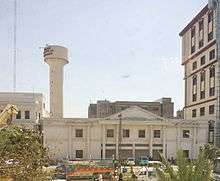Punjab Institute of Cardiology
| Punjab Institute of Cardiology | |
|---|---|
| Government of Punjab | |
 Tower of the hospital | |
 | |
| Geography | |
| Location | Main Jail Road, Opposite Race Course Park, Lahore., Lahore, Punjab, Pakistan |
| Coordinates | 31°32′19″N 74°20′09″E / 31.538685°N 74.335889°ECoordinates: 31°32′19″N 74°20′09″E / 31.538685°N 74.335889°E |
| Organisation | |
| Funding | Public |
| Services | |
| Emergency department | Yes |
| Helipad | No |
| Links | |
| Website | http://www.pic.punjab.gov.pk// |
| Lists | Hospitals in Pakistan |
Punjab Institute of Cardiology (PIC), located in Lahore, Pakistan, is a 292-bed tertiary care hospital providing nationwide comprehensive cardiac care services for the last 18 years. Its services include cardiac emergency, OPD, diagnostics, interventional and invasive cardiology and cardiac surgery. Fully equipped cardiac ambulatory services are also available round the clock. More than 160,000 patients are examined annually at OPD. More than 17,000 are admitted. PIC is the largest cardiac center in Pakistan with 24,000 echocardiographs, 4000 nuclear medicine procedures, 12,000 angiograms, 3500 angioplasties including 5000 stents and 2500 cardiac surgeries a year.
Punjab Institute of Cardiology is also actively involved in research and postgraduate training in cardiology, cardiac surgery and anesthesia. It is the first ISO certified hospital in the government sector.
A problem that occurred in January 2012 at this institution showed a problem with drug packaging. That month more than 100 heart patients died of overdoses from a particular drug that had inadequate labeling. Hundreds more patients suffered nonfatal adverse reactions from this drug. This problem, while bringing unwanted attention to the Punjab Institute of Cardiology, was not unique to that hospital system.[1][2]